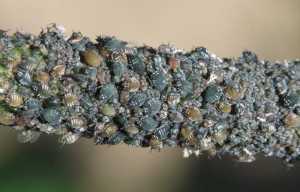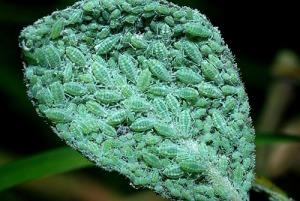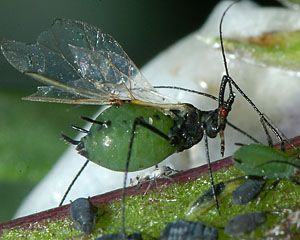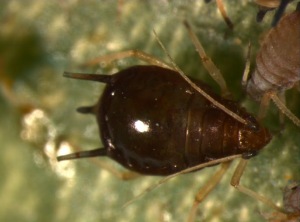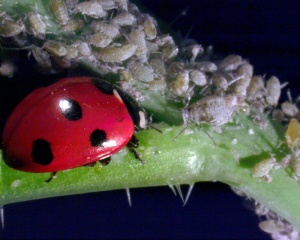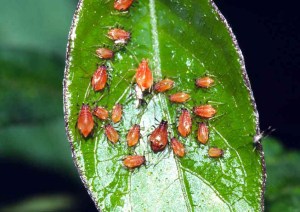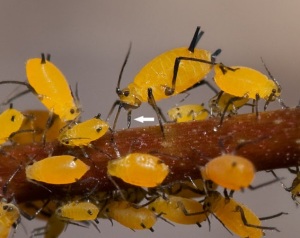One morning sometime in the late 1970s, when I was doing my PhD at the University of East Anglia, I walked into the lab to find one of my fellow PhD students sitting in front of a row of Petri dishes filled with different species of aphids. Curious, I asked him what he was doing. His reply was that he was tasting the aphids to see why his ladybirds made the choices they did. This was a guy whose hobby was collecting and identifying Chamaemymiid flies, so I was not entirely surprised, although I did point out that it was unlikely his taste receptors and those of the two-spot ladybird (Adalia bipunctata) had a lot in common.
That said, his premise that aphids don’t all taste the same was of course perfectly correct. Aphid predators, in particular ladybirds, seem to have quite strong preferences for different aphid species and these preferences are strongly correlated with larval development and subsequent fecundity as adults (Kalushkov, 1998; Kalushkov & Hodek, 2004). What is perhaps not as well-known is that certain aphids, like many lepidopteran larvae, are extremely good at sequestering potentially toxic chemicals from their host plants. Over a century ago, Johnson (1907) noted that highly coloured and woolly (in this case meaning waxy) aphids were not eaten as readily as smoother, greener aphids. Half a century later Hodek (1956, 1957), showed that larvae of the seven spot ladybird (Coccinella septempunctata) were unable to complete their development if fed a diet of the elder aphid Aphis sambuci and that young adult ladybirds died if fed on the same diet. Note that A. sambuci although not brightly coloured has waxy plaques on its abdomen.
Aphis sambuci http://aramel.free.fr/INSECTES10-4′.shtml
The mealy plum aphid, Hyalopterus pruni, although bright green, is also waxy, and when attacked by larvae of the ten spot ladybird, Adalia decempunctata, is released as oon as the ladybird larva comes into contact with the aphid’s haemolymph (insect blood) (Dixon, 1958).
Hyalopterus pruni, the mealy plum aphid http://influentialpoints.com/Gallery/Hyalopterus_pruni_Mealy_Plum_Aphid.htm
The vetch aphid Megoura viciae, on the other hand, is rather a handsome dark green aphid, with startlingly red eyes. If however, a larva of the ten-spot ladybird is foolish enough to eat
Megoura viciae, the vetch aphid http://influentialpoints.com/Gallery/Megoura_aphids.htm
one, it will, after about two minutes, be violently sick. Those are the lucky ones; those that don’t regurgitate the aphid are very likely to die a few days later. The two spot aphid, Adalia bipuncatata is also killed if it is unlucky enough to eat M. viciae (Blackman, 1967). It appears that the vetch aphid is full of all sorts of interesting and potentially fatal chemicals (Dixon et al., 1965). Truly a toxic treat. Megoura viciae is not the only toxic aphid out there. Aphis craccivora, the cowpea aphid, is a beautiful mahogany brown aphid, but despite its attractive
Aphis craccivora, the cowpea aphid
appearance, it is extremely toxic to the eleven spot ladybird Semiadalia undecimnotata, although the seven spot ladybird finds it perfectly acceptable (Hodek, 1970).
A similar effect is seen with the cabbage aphid, Brevicoryne brassicae, which is extremely good at sequestering glucosinolates, especially sinigrin, from its Brassica host plants. Glucosinolates are the compounds that give cabbages and related plants, such as Brussels sprouts, their distinctive flavour. In high dosages they can cause liver damage in young mammals, one of the reasons why children are so reluctant to eat cabbage, despite their parent’s urgings. Brevicoryne brassicae is so good at sequestering glucosinolates that larvae of the two spot ladybird die when fed on aphids from sinigrin rich cabbages (Kazana et al., 2007). The seven spot ladybird however, although not entirely happy when fed on a diet of sinigrin- rich cabbage aphids is able to survive, develop and reproduce successfully (Pratt et al., 2008). It obviously has a much better detoxification system than that of the two spot ladybird which for an aphidophagous predator seems singularly specialist.
Brevicoryne brassicae – the cabbage aphid; a colony being approached by a hungry seven spot ladybird (Photo Corin Pratt & Tom Pope).
Another aphid that sequesters plant derived toxins is the Stinkvine aphid, Acyrthosiphon nipponicus, which accumulates an iridoid glycoside, paederoside from it’s host plant the stinkvine Paederia foetidae (syn = scandens) (Nishida & Fukami, 1989). This brightly coloured aphid does not have to merge into the background; its chemical defence is so strong that
Acythrosiphon nipponicus – Stinkvine or Skunk-vine aphid http://homepage3.nifty.com/MICHI_A/akigase/AKIGASEKOUEN_hannsimoku2-1.htm
even that voracious predator the Harlequin ladybird, Harmonia axyridis, turns tail when dabbed with the aphid’s siphuncular fluid, or if it is unlucky enough to bite into the aphid, drops the aphid, regurgitates and rapidly leaves the leaf on which the aphid colony is feeding.
And finally, this striking, although rather noxious yellow aphid, the oleander aphid, Aphis nerii, which very honestly advertises that it is indeed a mouthful to be avoided.
Aphis neri – the oleander aphid http://www.zenthroughalens.com/2012/01/aphis-nerii-and-i.html
Aphis nerii is packed full ofcardiac glycosides which it sequesters from its host plant(Rothschild et al., 1970) and provides a powerful defence against potential predators, not just ladybirds.
So bear in mind, that although aphids may seem to be soft-bodied, small and defenceless, many of them are extremely well defended chemically as well as behaviourally. This suite of complex defence mechanisms may go some way to explain the ability of aphids to keep at least one step ahead of their natural enemies.
References
Blackman, R.L. (1967) The effects of different aphid foods on Adalia bipunctata L. and Coccinella septempunctata. Annals of Applied Biology, 59: 207-219 http://onlinelibrary.wiley.com/doi/10.1111/j.1744-7348.1967.tb04429.x/abstract
Dixon, A.F.G. (1958) The escape responses shown by certain aphid to the presence of the coccinellid Adalia decmpunctata. Transactions of the Royal Entomological Society London, 110: 319-334 http://onlinelibrary.wiley.com/doi/10.1111/j.1365-2311.1958.tb00786.x/abstract
Dixon, A.F.G., Martin-Smith, M. & Subramanian, G. (1965) Constituents of Megoura viciae Buckton. Journal of the Chemical Society, 296: 1562-1564.
Hodek, I. (1956) The influence of Aphis sambuci L. as prey of the ladybird beetle Coccinella septempunctata L. Acta Societatis Zoologicae Bohemoslovacae, 20: 62-74 (in Czech)
Hodek, I. (1957) The influence of Aphis sambuci L. as prey of the ladybird beetle Coccinella septempunctata L. II. Acta Societatis Entomoligicae Cechosloveniae, 54: 10-17 (in Czech)
Hodek, I. (1970) Coccinellids and the modern pest management. BioScience, 20:543-552
Johnson, R.H. (1907) Economic notes on aphids and coccinellids. Southwestern Entomologist: 12: 107-118
Kalushkov, P. (1998). Ten aphid species (Sternorrhyncha: Aphididae) as prey for Adalia bipunctata (Coleoptera: Coccinellidae). European Journal of Entomology 95: 343-349. http://www.eje.cz/scripts/viewabstract.php?abstract=412
Kalushkov, P. &Hodek, I. (2004). The effects of thirteen species of aphids on some life history parameters of the ladybird Coccinella septempunctata. Biocontrol 49: 21-32. http://link.springer.com/article/10.1023%2FB%3ABICO.0000009385.90333.b4
Kazana, E., Pope, T.W., Tibbles, L., Bridges, M., Picket, J.A., Bones, A.M. & Rossiter, J.T. (2007) The cabbage aphid: a walking mustard oil bomb. Proceedings of the Royal Society B., 274: 2271-2277. http://rspb.royalsocietypublishing.org/content/274/1623/2271.full
Nishida, R. & Fukami, H. (1989) Host plant iridoid-based chemical defense of an aphid, Acyrthosiphon nipponicus, against ladybird beetles. Journal of Chemical Ecology, 15: 1837-1845 http://link.springer.com/article/10.1007/BF01012270
Pratt, C., Pope, T.W., Powell, G. & Rossiter, J.T. (2008) Accumulation of glucosinolates by the cabbage aphid Brevicoryne brassciae as a defence against two Coccinellid species. Journal of Chemical Ecology, 34: 323-329 http://link.springer.com/article/10.1007/s10886-007-9421-z
Rothschild, M., von Euw, J. & Reichstein, T. (1970) Cardiac glycosides in the oleander aphid, Aphis nerii. Journal of Insect Physiology, 16: 1141-1145


